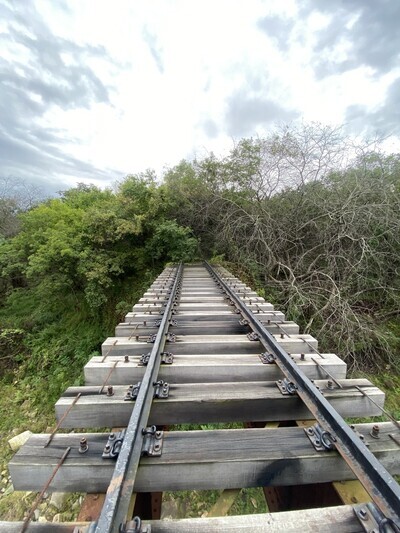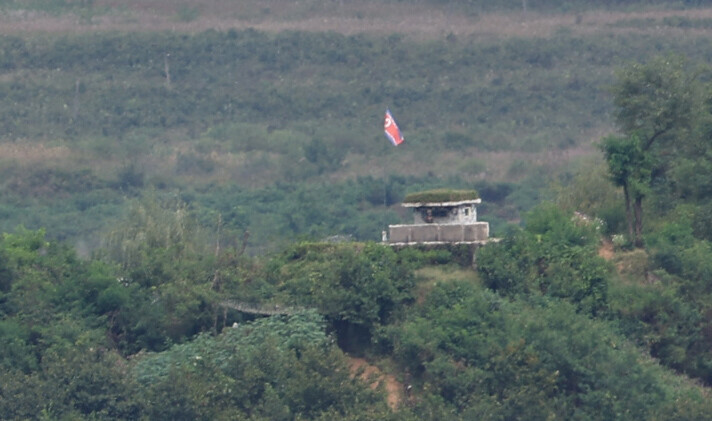hankyoreh
Links to other country sites 다른 나라 사이트 링크
[Column] To value peace, Korea must remember war


“Railroad interrupted! 90 km to Mt. Kumgang”
The message appears on the rust-colored Mt. Kumgang Electrical Railway Bridge in Jeongyeon Village, inside the Civilian Control Line in Cheorwon County, Gangwon Province.
Strange as it may sound today, the Mt. Kumgang Line opened in 1931, providing service between Cheorwon Station and Inner Kumgang Station. It was the first electrical railroad line on the Korean Peninsula aside from streetcars.
Eight trains ran the 116.6 km route each day. Because the line passed through rugged ravines, the trains could only manage around 30 kph, so the trip from Cheorwon to Inner Kumgang reportedly took around four and a half hours.
Even so, there were plenty of people willing to pay 7 won and 56 jeon for the trip — the price of a sack of rice at the time. Records for 1936 state that over 154,000 people traveled on the Mt. Kumgang Line that year.
On Friday, Hankyoreh shareholders, readers and supporters joined a two-day “DMZ ecology and peace tour” that was organized by the Hankyoreh Foundation for Reunification and Culture as one of the events commemorating the 35th anniversary of the newspaper’s establishment.
Walking along the bridge, I spotted the point where the railway sleepers broke off, giving way to dense shrubbery.

South Korean tours to Mt. Kumgang were indefinitely suspended just 10 years after they opened in 1998. It’s hard to believe that tourists traveled that same route on an electric train in the 1930s.
That’s especially hard to imagine in the present situation, when military tensions and rumors of war are on the rise as politicians talk about “peace through strength.”
In the 70 years since the July 27, 1953, signing of the armistice, most of us have become accustomed to a precarious but well-kept “cold peace.”
It takes a visit to the DMZ in Cheorwon and villages within Civilian Control Line, which were razed in the bloody battles that took place in the Korean War’s “Iron Triangle,” that one realizes that the war did not end 70 years ago but is still ongoing.
A walk up the Cheorwon Peace Observatory, which falls within the Civilian Control Zone, gives a bird’s-eye view of the verdant overgrowth of the DMZ.
It seems ironic that an outright ecological treasure trove — where geese and cranes flit freely to and fro over the barbed-wire fence that separates the two Koreas in preparation for the upcoming winter; an area home to 2,710 species of plants and animals, of which 44 are endangered — is the product of the Cold War.
The site of Cheorwon Public Primary School, which was the fourth-largest school in the country before the war with a student body of 2,600, remains a vast marsh where cattails grow due to its inaccessibility, having been cut off from the world on account of landmines in the area.
It is estimated that it will take 480 years to remove all the mines laid by the two Koreas in the DMZ, which makes the prospect of making the area mine-free seem near impossible.
On our excursion, the Hankyoreh was joined by 30 people from Seoul, Incheon, Yongin, Sejong, Gwangju, Jeonju and Chuncheon, ranging from 15-year-old students to seniors in their 80s. Many of them wake up at dawn and start their day by reading the Hankyoreh.
Participants enthusiastically shared their opinions about the Hankyoreh. Some suggested that there should be a special section on Friday that could be read on the weekend for those who live in areas that don’t get the paper on weekends. Some also said that the articles were too difficult and felt as though they fell into bothsidesism at times.

The participants expressed their concerns and regrets about the situation on the Korean Peninsula as eloquently as their support and constructive criticism of the Hankyoreh.
“Conservative discourse, which worships war as some sort of myth, is overtaking our society,” said an Army reservist captain in their 30s who writes about peace.
“Both the ROKS Cheonan sinking and Yeonpyeong Island incidents happened under conservative governments, but a big part of the blame being placed on [progressives] is that progressive media like the Hankyoreh and the progressive camp fail to properly embrace and respond to the pain of the young people who have been victimized.”
Young people have been, are, and will always be the first to fall victim to war and military tensions.
South Korean casualties during the Korean War were concentrated in the mountainous battles that took place along the central front in areas such as Cheorwon. These battles for the hills began around July 1951, when armistice talks began, and raged on for two years until the armistice was signed.
Tens of thousands of people died on the 219-meter-high Sabseulbong, dubbed “Ice Cream Hill” by foreign reporters because the relentless bombing made it seem as if the hill were melting away.
The Battle of White Horse Hill, which changed hands 24 times in 10 days, saw 3,500 South Korean and 10,000 Chinese soldiers killed. For two years, instead of engaging in dialogue based on mutual concessions, negotiations dragged on like a war in their own right, and hill warfare became a political tool for both sides, forcing them to repeatedly engage in battles that had no real winners or losers.
In 1994, when the North Korean nuclear crisis appeared to be taking the peninsula to the brink of war, a US plan to launch a preemptive strike on the Yongbyon nuclear facility was prevented only by estimates of the death toll in the event of an all-out war.
President Kim Young-sam later claimed that he had prevented the attack, but it is a little-known fact that Kim told the South Korean military to “never cooperate” in response to the fact that the US failed to consult with South Korea in advance.
The fact that Kim, who had fueled tensions with his strongly worded response to North Korea’s “sea of fire” remark, showed a different side in the moment of crisis is likely due to the fact that, regardless of his ideology, he was the president of a country that had already experienced war once before.
In a first for a South Korean president, Yoon Suk-yeol hosted an event marking the 73rd anniversary of the Incheon landing operation last week on Sept. 15, where he called the operation “a legacy that the free world must remember as the proud history of our liberal democracy that defeated the communist totalitarian forces.”
However, as a president charged with a mission to protect the lives and safety of civilians, shouldn’t he first acknowledge the lessons of harrowing battles of the hills during the Korean War?
As I left Cheorwon, I couldn’t help but think that those who mock peace as idealistic may be the same people who turn a blind eye to the reality of war.

Please direct questions or comments to [english@hani.co.kr]

Editorial・opinion
![[Column] Is Korean democracy really regressing? [Column] Is Korean democracy really regressing?](https://flexible.img.hani.co.kr/flexible/normal/500/300/imgdb/original/2024/0705/2917201664129137.jpg) [Column] Is Korean democracy really regressing?
[Column] Is Korean democracy really regressing?![[Column] How tragedy pervades weak links in Korean labor [Column] How tragedy pervades weak links in Korean labor](https://flexible.img.hani.co.kr/flexible/normal/500/300/imgdb/original/2024/0703/8717199957128458.jpg) [Column] How tragedy pervades weak links in Korean labor
[Column] How tragedy pervades weak links in Korean labor- [Column] How opposing war became a far-right policy
- [Editorial] Korea needs to adjust diplomatic course in preparation for a Trump comeback
- [Editorial] Silence won’t save Yoon
- [Column] The miscalculations that started the Korean War mustn’t be repeated
- [Correspondent’s column] China-Europe relations tested once more by EV war
- [Correspondent’s column] Who really created the new ‘axis of evil’?
- [Editorial] Exploiting foreign domestic workers won’t solve Korea’s birth rate problem
- [Column] Kim and Putin’s new world order
Most viewed articles
- 110 days of torture: Korean mental patient’s restraints only removed after death
- 2Months after outcry over “torture devices,” Justice Ministry proposes more restraints for immigratio
- 3Former bodyguard’s dark tale of marriage to Samsung royalty
- 4[Column] Is Korean democracy really regressing?
- 5Beleaguered economy could stymie Japan’s efforts to buoy the yen
- 6Real-life heroes of “A Taxi Driver” pass away without having reunited
- 7[Column] How tragedy pervades weak links in Korean labor
- 8Koreans are getting taller, but half of Korean men are now considered obese
- 9Foreign day laborers make up majority of death toll in Korean battery factory fire
- 10[Editorial] Exploiting foreign domestic workers won’t solve Korea’s birth rate problem